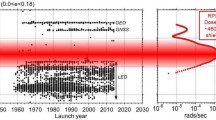Abstract
Instrumentation for particle and high-energy photon measurements in space must provide high levels of performance while meeting the severe constraints imposed by flight. Direct measurements are required spanning over 13 decades in energy and covering species ranging from photons to the heaviest nuclei in the periodic table. Indirect measurements increase the energy range by another five decades. Many of the detection techniques used are shared with accelerator instruments and other ground-based applications, but the implementation is often unique to space. This chapter sets the context for the required measurements and reviews representative instruments for direct measurements of photons and particles from 100 eV to 1015 eV and indirect measurements to over 1020 eV.
Access this chapter
Tax calculation will be finalised at checkout
Purchases are for personal use only
Similar content being viewed by others
References
Ahn HS et al (2007) The cosmic ray energetics and mass (CREAM) instrument. Nucl Inst Methods Phys Res A 579:1034–1053
Akimov VV et al (1970) Measurements of the primary cosmic ray spectra in the 1011–1014 eV energy range from proton-1, 2, 3 satellites. Proceedings of the 11th international conference on cosmic rays, vol 1. Budapest, p 517
Atwood WB et al (2009) The large area telescope on the fermi gamma-ray space telescope mission. Astrophys J 697:1071–1102
Barthelmy SD et al (2005) The burst alert telescope (BAT) on the SWIFT midex mission. Space Sci Rev 120:143–164
Bieber JW (1999) Antiprotons at solar maximum. Phys Rev Lett 83(4):674–677
Fisk LA (1971) Solar modulation of galactic cosmic rays. J Geophys Res 76:221–226
Gehrels N et al (2004) The swift gamma-ray burst mission. Astrophys J 611:1005–1020
Gehrels N, Ramirez-Ruiz E, Fox DB (2009) Gamma-ray bursts in the swift era. Annu Rev Astron Astrophys 47:567–617
Giacconi R et al (1962) Evidence for X rays from sources outside the solar system. Phys Rev Lett 9:439–443
Gorham PW et al (2009) New limits on the ultrahigh energy cosmic neutrino flux from the ANITA experim. Astropart Phys 32:10–41
Gruber DE et al (1996) The high energy X-ray timing experiment on XTE. Astron Astrophys Suppl Ser 120:641–644
Guzik TG et al (2004) The ATIC long duration balloon project. Adv Space Res 33:1763–1770
Hoover S et al (2010) Observation of ultrahigh-energy cosmic rays with the ANITA balloon-borne radio interferometer. Phys Rev Lett 105:151101
Jahoda K et al (2006) Calibration of the Rossi X-ray timing explorer proportional counter array. Astrophys J Suppl Ser 163:401–423
Koglin JE et al (2005) NuSTAR hard X-ray optics. Proc SPIE 59000:59000X-1
Kounine A et al (2010) Status of the AMS experiment. arXiv:1009.5349
Levine AM et al (1996) First results from the all-sky monitor on the Rossi X-ray timing explorer. Astrophys J 469:L33–L36
Mason GM et al (1998) The ultra-low-energy isotope spectrometer (ULEIS) for the ACE spacecraft. Space Sci Rev 86:409–448
Mitchell JW et al (2004) The BESS program. Nucl Phys B Proc Suppl 134:31–38
Müller D et al (2004) Transition radiation detectors in particle astrophysics. Nucl Inst Methods Phys Res A 522:9
Nichol JR et al (2011) Radio detection of high-energy particles with the ANITA experiment. Nucl Inst Methods Phys Res A 626–627:S30–S35
Obermeier A (2011) A direct measurement of cosmic rays to very high energies: implications for galactic propagation and sources. PhD thesis, Radboud University, Nijmegen, The Netherland, ISBN 978-90-9025962-8
Picozza P et al (2007) PAMELA a payload for antimatter matter exploration and light-nuclei astrophysics. Astropart Phys 27:296–315
Rauch BF et al (2009) Cosmic ray origin in OB associations and preferential acceleration of refractory elements: evidence from abundances of elements 26Fe through 34Se. Astrophys J 697:2083–2088
Stecker FW et al (2004) Observing the ultrahigh energy universe with OWL eyes. Nucl Phys B 136C:433–438
Stephens SA, Balasubrahmanyan VK (1985) High energy gamma ray observatories for the study of cosmic ray electrons above 1014 eV. Nucl Inst Methods Phys Res A 241:257–264
Stone EC et al (1998a) The advanced composition explorer. Space Sci Rev 86:1–22
Stone EC et al (1998b) The solar isotope spectrometer for the advanced composition explorer. Space Sci Rev 86:357–408
Stone EC et al (1998c) The cosmic-ray isotope spectrometer for the advanced composition explorer. Space Sci Rev 86:285–356
Strong AW, Moskalenko IV, Ptuskin VS (2007) Cosmic-ray propagation and interactions in the galaxy. Ann Rev Nucl Part Sci 57:285–327
Takahashi Y et al (2009) The JEM-EUSO mission. New J Phys 11:065009
Torii S et al (2011) Calorimetric electron telescope mission. Search for dark matter and nearby sources. Nucl Inst Methods Phys Res A 630:55–57
Yamamoto A et al (2011) Search for cosmic-ray antiproton origins and for cosmological antimatter with BESS. Adv Space Res. (in press)
Author information
Authors and Affiliations
Corresponding author
Editor information
Editors and Affiliations
Rights and permissions
Copyright information
© 2021 Springer Nature Switzerland AG
About this entry
Cite this entry
Mitchell, J.W., Hams, T. (2021). Astrophysics and Space Instrumentation. In: Fleck, I., Titov, M., Grupen, C., Buvat, I. (eds) Handbook of Particle Detection and Imaging. Springer, Cham. https://doi.org/10.1007/978-3-319-93785-4_23
Download citation
DOI: https://doi.org/10.1007/978-3-319-93785-4_23
Published:
Publisher Name: Springer, Cham
Print ISBN: 978-3-319-93784-7
Online ISBN: 978-3-319-93785-4
eBook Packages: Physics and AstronomyReference Module Physical and Materials ScienceReference Module Chemistry, Materials and Physics




